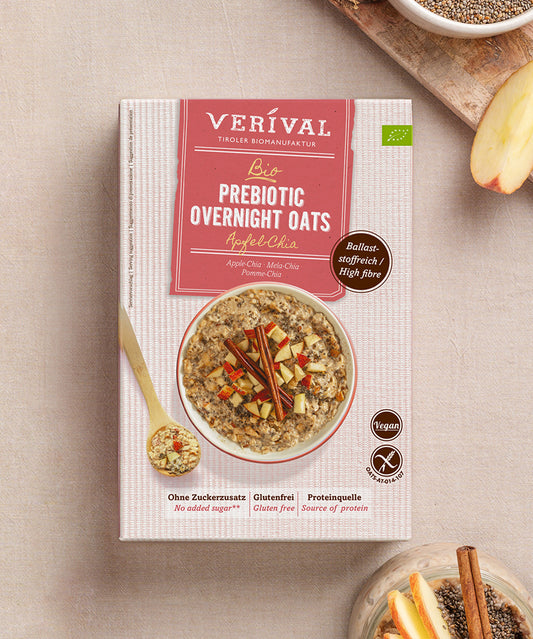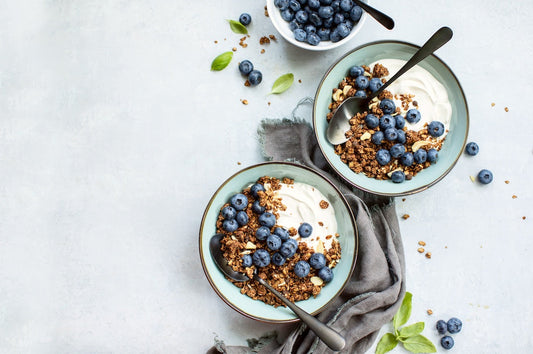Eating intuitively and still living healthily sounds like a pipe dream to many of us. However, listening to your body is not that difficult – in fact, anyone can learn how. In this article, we will tell you exactly what intuitive eating is, why it is so good for us and how you too can learn it.
Organic porridges from Verival – discover them now
Intuitive eating – why it is so good for us
If you want to lose weight, you have to give up something. This, or something similar, is the approach taken by many diets. However, there is another option that is not only more sustainable but also, and more importantly, tastier. This is known as intuitive eating. The idea is to listen to your body and only give it what it really needs and what is good for it.
If this sounds unrealistic to you, that's perfectly understandable. However, it is not a magical weight loss strategy, but rather a healthy attitude towards food. Changes are not achieved through radical calorie reduction and extensive calorie tracking, but through a step-by-step and sustainable change in eating behaviour.
If you are looking for a quick weight loss, this will not get you very far. But isn't it much more desirable to feel comfortable in your own body and not to have to constantly struggle with the yo-yo effect?
Once you have managed to correctly interpret your body's signals, maintaining your ideal weight will no longer be difficult. But how exactly do you do intuitive eating?
How to make a lasting change to your eating behaviour
The most important thing about intuitive eating is to develop a feeling for your body's hunger and satiety. In most cases, this takes a little time and it is quite possible that you will gain a little weight at first. However, there is no need to worry, because you and your body need a short period of adjustment before you can live in harmony and understand each other.
It may sound strange, but it actually takes some time to be able to understand and correctly interpret the body's signals. This is because the signals for appetite, thirst and actual hunger are very similar and can easily be misunderstood. Misreading your body's signals from time to time is not a problem at all and is part of the process, because, as we all know, the quickest way to learn is to make mistakes.
Intuitive eating starts with breakfast
After waking up, you may feel hungry. However, this is often more of a thirst sensation than hunger. It's best to drink a glass of water first and then see what happens.
This is why a healthy breakfast is so important – find out more
In most cases, your supposed feeling of hunger will be somewhat satisfied, but it is quite normal to be hungry in the morning. If you don't yet have a feel for suitable portion sizes, you can usually stick to the portion suggestions on the packaging. These are usually calculated according to the nutritional guidelines of specialised organisations, which is why they provide a good starting point.
A little tip along the way – if you take a closer look at the packaging, you can immediately see the nutrition table. This will help you develop a feel for the calories and nutrients contained. After a while, you will know how much of your favourite products you should ideally eat.
For example, 50 grams of the ready-mix is considered a portion of our Verival porridges. For your first attempts, it is best to prepare your breakfast according to the recommendation – you can't go wrong with that.
However, it is now much more important that you really concentrate on the food itself while eating. This means that you should ideally put your mobile phone aside, prepare your food nicely, and enjoy every single bite. This not only ensures a calmer start to the day, but also helps you to be more sensitive to your body's signals. Eating slowly and not gulping down one bite after another also helps you to better perceive when you are full.
How healthy is a vegan diet? Find out more.
This is how you can learn to trust your body
If you make this behaviour part of your routine and stick to it at as many of your meals as possible, you will soon feel a change. Your body's signals will become clearer and it will become easier and easier for you to take the appropriate action.
You should avoid these foods
However, some foods can be a real stumbling block on the road to intuitive eating. In particular, sugary products can lead to unwanted signals from your body. This is because their high glycaemic index causes your blood sugar level to rise quickly, only to fall just as quickly. This makes you prone to food cravings. To avoid this, you should avoid sugary foods such as soft drinks or sweet snacks like chocolate, biscuits and the like as much as possible, or at least limit your consumption of them.
Are smoothies really healthy? Find out more
Another source of danger is food that has a certain ratio of fat to carbohydrates. Crisps are probably the best-known example – it has certainly happened to you before that the packet was suddenly empty even though you only wanted to have a small snack to begin with. The reason for this is that the usual ratio of fats to carbohydrates in crisps activates the reward centre and the body demands more and more. To avoid falling into this trap, you should therefore avoid crisps in front of the television 😉
If you prepare your snacks yourself, you no longer need to worry about this – how about the following recipe, for example?
Conclusion
Intuitive eating is about giving your body only what it really needs. The main thing is to develop a feel for your body and to be able to interpret the signals correctly. Quick weight loss is not usually observed, but the results are long-lasting and therefore significantly more sustainable.
Here is a brief overview of the most important tips and tricks:
- Be patient and don't go for quick fixes.
- Experiment a little – as everyone knows, the quickest way to learn from your mistakes is to make them
- Use the portion sizes given as a guide at the beginning – they are a good starting point
- Take a look at the nutrition table from time to time to get a feel for the nutritional values
- Take time to eat and consciously enjoy your meals
- Avoid sugary snacks or tempting crisps – they can send out misleading signals.
But the most important thing is to give yourself and your body enough time to adjust to each other in order to achieve long-term success. Eating mindfully and at a relaxed pace can help you to better perceive your body's signals. It's best to start with your breakfast, so we wish you a relaxed start to the day and bon appétit 😉
























